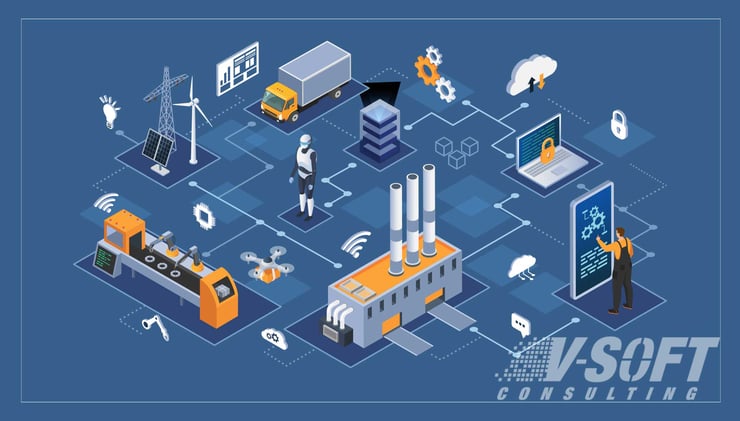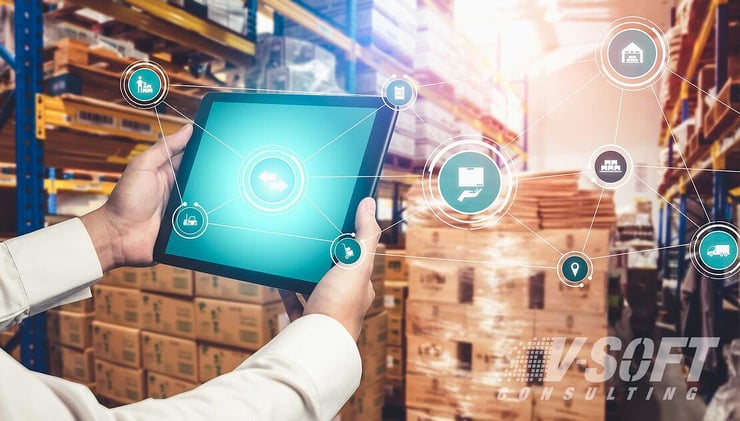Automation has been playing a key role in transforming the manufacturing industry, from supply chain management (SCM) to logistics. So what does supply chain automation refer to? How can automation and the Internet of Things (IoT) change logistics and supply chain management?
Automation refers to the process of utilizing technologies to automate manual work. This can be achieved by using different applications, APIs, or simply by connecting data using IoT. The manufacturing industry is encompassed with multiple types of equipment, steps, and processes that lead to a finished product – supply chain and logistics play a vital role in this process. To stay competitive, businesses must improve their workflows to increase efficiency, and automation can help achieve that.
By 2023, at least 50% of large global companies will be integrating AI, advanced analytics, and IoT in supply chain operations. -Gartner
What is Supply Chain Automation?
Supply chain automation refers to leveraging digital technologies like Artificial Intelligence (AI), Machine Learning (ML), and Robotic Process Automation (RPA) to improve supply chain efficiency, automate, and streamline processes.
Automating the supply chain lowers operational costs of product and service delivery. Whether automating an entire supply chain or just a piece of it, decreasing human labor can increase profits and boost productivity and process accuracy.
How Supply Chain Automation Can Improve Your Business
There are many benefits to adopting supply chain automation. Let’s check out 7 ways this transformative process can improve business.
1. Automates Back-Office, Manual Tasks
Supply chain processes include necessary document processing a data entry, such as organizing and processing order receipts, delivery details, product details, invoices, etc. Sorting this paperwork can be time-consuming. Automating these tasks can increase the speed of completion, improve work accuracy by eliminating human error, and increase efficiency.
2. Creates Transparency and Visibility
The conventional supply chain lacks transparency. Automating a supply chain connects all systems to create a centralized location that provides real-time data, status updates, and one single source of truth for the entire supply chain. This helps retrieve data and allows workers to monitor progress. It also provides customers with an overview of their order progress.
3. Automates Transportation
With the help of AI, organizations can track their delivery vehicles in real-time. They can access information about the products, shipping address, and delivery details, and receive notifications. Companies also get notified about potential delays due to circumstances such as bad weather, traffic jams, or vehicle issues. This allows manufacturers to optimize transportation, reducing delivery time and cost.
4. Offers Quick Action and Response
We can’t predict what the future holds, but by integrating data with automation platforms, companies can make agile decisions to unexpected scenarios. This helps organizations respond quickly to business needs.
5. Ensures Protocols
Different manufacturing sites worldwide follow various health and safety regulations. In such scenarios, automating business process workflows and documenting them is ideal to ensure regulations are met. Additionally, automation offers real-time visibility into the supply chain, helps identify issues, prevent them, and improve risk management.
6. Improves Customer Satisfaction
Customer satisfaction is directly impacted when the time between ordering and fulfillment is reduced. Automation allows companies to better serve customers by providing them updates on order statuses in real-time.
7. Improves Inventory Control
Automation can enhance inventory and order tracking and help reduce stock inconsistencies. Changes are automatically updated so employees know which products are available and which are out of stock. Automating the supply chain improves demand forecasting with automated supply chain procedures.

IoT for Logistics and Supply Chain Management
Logistics and SCM play a crucial role in the manufacturing industry. The supply chain involves critical demand planning, procurement, inventory, and logistics processes. Logistics includes activities such as inventory control, warehousing, and transport management. IoT is playing a crucial role in the manufacturing industry. Let's uncover some of the aspects of using IoT in the supply chain.
Role of IoT in Supply Chain
IoT devices have changed the way supply chains are managed. With IoT, it's now easier to figure out where items are, how they're stored, and when they will arrive at their final destination.
- Track Location of Goods 24/7
IoT devices can connect to individual storage containers of raw materials and finished goods. This allows the location of the containers to be tracked 24x7through GPS. - Forecast Product Arrival
IoT devices help predict how goods will move through the supply chain, depending on the shipment speed, traffic flow, and delays. This allows suppliers, manufacturers, and distribution centers to plan when to receive items, reducing handling delays and even creating contingency plans to help the supply chain move more quickly. - Monitor Stored Products and Raw Materials
Food and chemical products require optimal storage conditions. IoT monitors environmental parameters, such as weather, temperature, and humidity to keep goods safe. IoT devices alert when anything exceeds specified criteria, keeping products safe from spoilage. - Locate Items in Storage
In massive warehouses, it isn't easy to find goods, but IoT makes it easier to locate individual products and ensure they are accurately identified and managed. - Act Immediately Upon Receipt of Goods
IoT devices can validate exactly when products arrive and can trigger the next steps such as supplier payments or onward shipping requests.
Role of IoT in Logistics
Here’s how automating logistics with IoT can streamline manufacturing.
- Route Management and Delivery Tracking
IoT offers route management, which enables managers to fetch the location of containers in real-time. By leveraging GPS tracking systems, vehicles can be monitored and companies can track and ensure timely delivery. - Inventory Tracking
Instead of using barcodes, smart labels, or radio-frequency identification (RFID) tags to store all product information. These microchips update data in real-time for better visibility into inventory. - Warehouse Optimization
IoT-powered sensors allow manufacturers to set rules to maintain stable and suitable humidity and temperature levels. These sensors can also detect fire and other hazardous situations affecting warehouses. - Predictive Maintenance
Manufacturing companies often operate large vehicles, and there can be a struggle in optimizing maintenance costs. Predictive maintenance can save companies from losing millions of dollars by retrofitting machinery with IoT-powered sensors that monitor vibration, noise, and temperature. This helps spot early signs of malfunction and prevents damage.
















